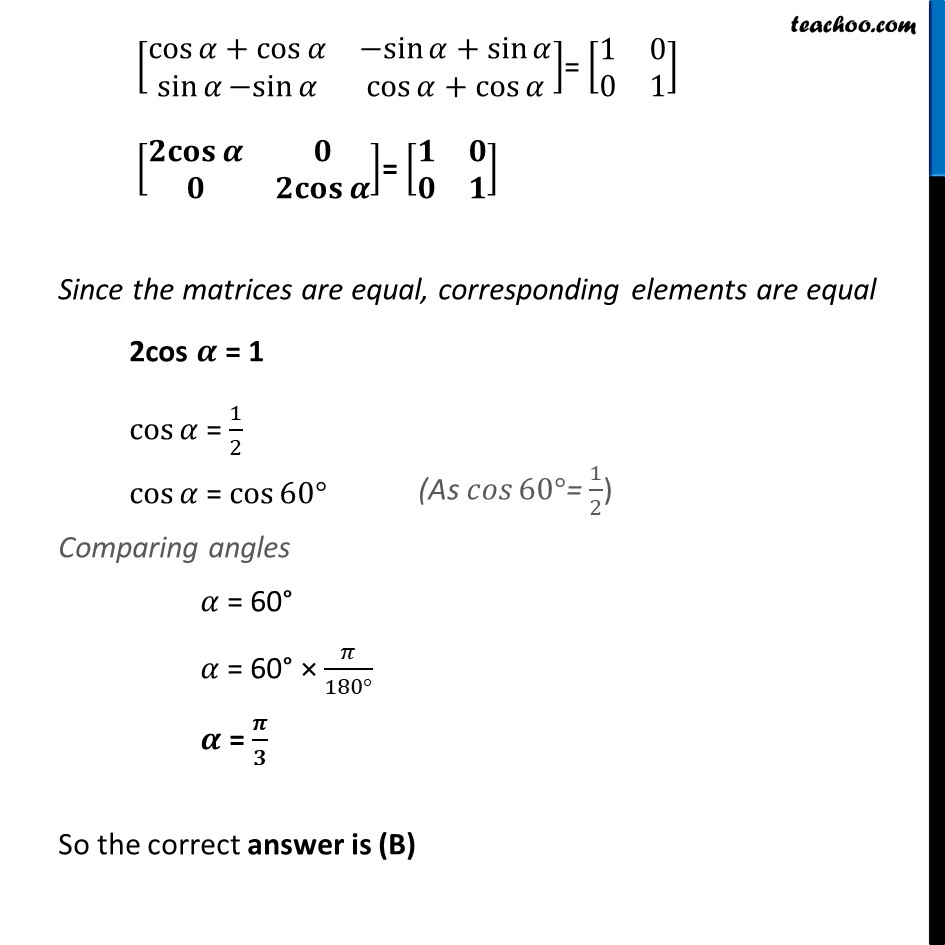![Ex 3.3, 12 (MCQ) - If A = [cos a -sin a sin a cos a], then A + A’ = I - Ex 3.3](https://cdn.teachoo.com/dc5f223f-a963-4e46-878e-d881d1c2dcac/slide49.jpg)

Transpose of a matrix
Last updated at December 16, 2024 by Teachoo
![Ex 3.3, 12 (MCQ) - If A = [cos a -sin a sin a cos a], then A + A’ = I - Ex 3.3](https://cdn.teachoo.com/dc5f223f-a963-4e46-878e-d881d1c2dcac/slide49.jpg)

Transcript
Ex 3.3, 12 If A = [■8(cos 𝛼&〖−sin〗𝛼@sin𝛼&cos𝛼 )] , then A + A’ = I , if the value of α is A. 𝛑/𝟔 B. 𝛑/𝟑 C. π D. 𝟑𝛑/𝟐 A = [■8(cos𝛼&〖−sin〗𝛼@sin𝛼&cos𝛼 )] A’= [■8(cos𝛼&sin𝛼@〖−sin〗𝛼&cos𝛼 )] and I = [■8(1&0@0&1)] Given A + A’ = I [■8(𝐜𝐨𝐬𝜶&〖−𝐬𝐢𝐧〗𝜶@𝐬𝐢𝐧𝜶&𝐜𝐨𝐬𝜶 )] + [■8(𝐜𝐨𝐬𝜶&𝐬𝐢𝐧𝜶@〖−𝐬𝐢𝐧〗𝜶&𝐜𝐨𝐬𝜶 )] = [■8(𝟏&𝟎@𝟎&𝟏)] [■8(cos〖𝛼+cos𝛼 〗&〖−sin〗〖𝛼+sin𝛼 〗@sin𝛼 〖−sin〗𝛼&cos〖𝛼+cos𝛼 〗 )]= [■8(1&0@0&1)] [■8(𝟐𝐜𝐨𝐬𝜶&𝟎@𝟎&𝟐𝐜𝐨𝐬𝜶 )]= [■8(𝟏&𝟎@𝟎&𝟏)] Since the matrices are equal, corresponding elements are equal 2cos 𝜶 = 1 cos𝛼 = 1/2 cos𝛼 = cos〖60°〗 Comparing angles 𝛼 = 60° 𝛼 = 60° × 𝜋/(180°) 𝜶 = 𝝅/𝟑 So the correct answer is (B)